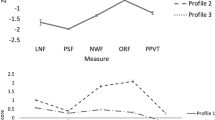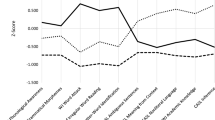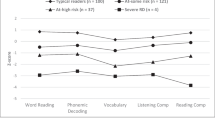Abstract
The United States’ National Institute for Literacy’s (NIFL) review of adult literacy instruction research recommended adult education (AE) programs assess underlying reading abilities in order to plan appropriate instruction for low-literacy learners. This study developed adult reading ability groups using measures from power tests and speeded tests of phonemic decoding, word recognition, fluency, and comprehension. A multiple cluster analysis of these reading ability scores from 295 low-literacy AE participants yielded seven reading ability groups. These groups are described in terms of instructional needs relevant to an instructor’s planning and activities.




Similar content being viewed by others
Abbreviations
- ABE:
-
Adult Basic Education
- AE:
-
Adult Education
- ASE:
-
Adult Secondary Education
- CASAS:
-
Comprehensive Adult Student Assessment System
- NIFL:
-
National Institute for Literacy
- NRS:
-
National Reporting System
- QRI:
-
Qualitative Reading Inventory
- TABE:
-
Test of Adult Basic Education
- TOSWRF:
-
Test of Silent Word Reading Fluency
- TOWRE:
-
Test of Word Reading Efficiency
- USDE:
-
U.S. Department of Education
- WRMT-R:
-
Woodcock Reading Mastery Tests-Revised
References
Adolf, S., Catts, H., & Little, T. (2006). Should the simple view of reading include a fluency component? Reading and Writing, 19, 933–958.
Blashfield, R., & Draguns, J. (1976). Evaluative criteria for psychiatric classification. Journal of Abnormal Psychology, 85, 140–145.
Catts, H., Hogan, T., & Adolf, S. (2005). Developmental changes in reading and reading disabilities. In H. Catts & A. Kamhi (Eds.), Connections between language and reading disabilities (pp. 25–40). Mahwah, NJ: Erlbaum.
Comprehensive Adult Student Assessment System (CASAS). (2001). CASAS technical manual. San Diego, CA: Author.
CTB/McGraw-Hill. (1997). TABE: Tests of adult basic education. Monterey, CA: Author.
Edwards, J., Walley, A., & Ball, K. (2003). Phonological, visual and temporal processing in adults with and without reading disability. Reading and Writing: An Interdisciplinary Journal, 16, 737–758.
Ehri, L., & Sweet, J. (1991). Finger-point reading of memorized text: What enables beginners to process the print? Reading Research Quarterly, 26, 442–462.
Everitt, B. (1980). Cluster analysis. London: Heineman Educational Books.
Francis, D., Fletcher, J., Catts, H., & Tomblin, J. (2005). Dimensions affecting the assessment of reading comprehension. In S. G. Paris & S. A. Stahl (Eds.), Children’s reading comprehension and assessment (pp. 369–394). Mahwah, NJ: Erlbaum.
Gough, P., Hoover, W., & Peterson, C. (1996). Some observations on a simple view of reading. In C. Cornoldi & J. Oakhill (Eds.), Reading comprehension difficulties: Processes and intervention (pp. 1–13). Mahwah, NJ: Erlbaum.
Gough, P., & Tunmer, W. (1986). Decoding, reading, and reading disability. Remedial and Special Education, 7, 6–10.
Jenkins, J., Fuchs, L., van den Broek, P., Espin, C., & Deno, S. (2003). Accuracy and fluency in list and context reading of skilled and RD groups: Absolute and relative performance levels. Learning Disabilities Research & Practice, 18, 237–245.
Joshi, R. M., & Aaron, P. D. (2000). The component model of reading: Simple view of reading made a little more complex. Reading Psychology, 21, 85–97.
Kruidenier, J. (2002a). Research-based principles for adult basic education reading instruction. Washington, DC: National Institute for Literacy.
Kruidenier, J. (2002b). Literacy education in Adult Basic Education. Review of adult learning and literacy (Vol. 3, Chapter 4). Retrieved March 20, 2008, from http://www.ncsall.net/?id=574.
Kutner, M., Greenberg, E., & Baer, J. (2005). National Assessment of Adult Literacy (NAAL): A first look at the literacy of America’s adults in the 21st century. (Report No. NCES 2006–470). Washington, DC: National Center for Educational Statistics.
Kutner, M., Greenberg, E., Jin, Y., Boyle, B., Hsu, Y., & Dunleavy, E. (2007). Literacy in everyday life: Results from the 2003 National Assessment of Adult Literacy (NCES 2007–480). Washington, DC: U.S. Department of Education, National Center for Education Statistics.
LaBerge, D., & Samuels, S. (1974). Toward a theory of automatic information processing in reading. Cognitive Psychology, 95, 3–21.
Leinonen, S., Müller, K., Leppänen, P., Aro, M., Ahonen, T., & Lyytinen, H. (2001). Heterogeneity in adult dyslexic readers: Relating processing skills to the speed and accuracy of oral text reading. Reading and Writing: An Interdisciplinary Journal, 14, 265–296.
Lesgold, A., & Perfetti, C. (1978). Interactive processes in reading comprehension. Discourse Processes, 1, 323–336.
Leslie, L., & Caldwell, J. (2001). Qualitative reading inventory. New York: Longman.
Lindamood, P., Bell, N., & Lindamood, P. (1992). Issues in phonological awareness assessment. Annals of Dyslexia, 42, 242–259.
Maclay, C., & Askov, E. (1988). Computers and adult beginning readers: An intergenerational study. Lifelong Learning: An Omnibus of Practice and Research, 11, 23–28.
Mather, N., Hammill, D., Allen, E., & Roberts, R. (2004). Test of silent reading word proficiency. Austin, TX: PRO-ED.
McShane, S. (2005). Applying research in reading instruction for adults. Washington, DC: National Institute for Literacy.
Moore, M., & Stavrianos, M. (1995). Review of adult education programs and their effectiveness: A background paper for reauthorization of the adult education act. Washington, DC: Mathematica Policy Research, Inc.
Morris, R., Blashfield, R., & Satz, P. (1981). Neuropsychology and cluster analysis: Problems and pitfalls. Journal of Clinical Neuropsychology, 3, 79–99.
Morris, R., Stuebing, K., Fletcher, J., Shaywitz, S., Lyon, G. R., Shankweiler, D., et al. (1998). Subtypes of reading disability: Variability around a phonological core. Journal of Educational Psychology, 90, 347–373.
National Center for Education Statistics. (2006). Adult education participation in 2004–05 (NCES-2006077). Washington, DC: U.S. Department of Education, Institute for Educational Science. Retrieved September 11, 2007, from http://nces.ed.gov/pubsearch/pubsinfo.asp?pubid=2006077.
National Institute of Child Health and Human Development. (2000). Report of the National Reading Panel. Teaching children to read: An evidenced-based assessment of the scientific research literature on reading and its implications for reading instruction. Reports of the subgroups. (NIH Publication No. 00-4754). Washington, DC: U.S. Government Printing Office.
Perfetti, C. (1985). Reading ability. New York: Oxford University Press.
Pikulski, J., & Chard, D. (2005). Fluency: Bridge between decoding and reading comprehension. The Reading Teacher, 58, 510–519.
Sabatini, J. (2002). Efficiency in word reading of adults: Ability group comparisons. Scientific Studies of Reading, 6, 267–298.
Samuels, S. J. (2006). Toward a model of reading fluency. In S. J. Samuels & A. E. Farstrup (Eds.), What research has to say about fluency instruction (pp. 24–46). Newark, DE: International Reading Association.
Samuels, S. J., & Wu, Y. (2003). How the amount of time spent on independent reading affects reading achievement: A response the National Reading Panel. Retrieved June 7, 2006, from http://www.tc.umn.edu/~samue001.
Stanovich, K. (1980). Toward an interactive-compensatory model of individual differences in the development of reading fluency. Reading Research Quarterly, 16, 32–71.
Strucker, J., & Davidson, R. (2003). Adult reading components study (ARCS). Retrieved July 19, 2006, from http://www.ncsall.net/fileadmin/resources/research/brief_strucker2.pdf.
Torgesen, J. T., Wagner, R. K., & Rashotte, C. A. (1999). Test of word reading efficiency (TOWRE). Austin, TX: PRO-ED.
U.S. Department of Education. Office of Adult and Vocational Education, Division of Adult Education and Literacy. (2001). Measures and methods for the National Reporting System for adult education: Implementation guidelines. Washington, DC: Author.
Walczyk, J., & Griffith-Ross, D. (2007). How important is reading skill fluency for comprehension? The Reading Teacher, 60(6), 560–569.
Woodcock, R. (1998). Woodcock reading mastery tests-revised: Examiner’s manual. Circle Pines, MN: American Guidance Service, Inc.
Acknowledgements
This paper reports findings from a study funded by the National Institute of Child Health and Human Development, National Institute for Literacy, and the U.S. Department of Education Office of Vocational and Adult Education (Award # RO 1 HD 43775).
Author information
Authors and Affiliations
Corresponding author
Rights and permissions
About this article
Cite this article
Mellard, D.F., Fall, E. & Mark, C. Reading profiles for adults with low-literacy: cluster analysis with power and speeded measures. Read Writ 22, 975–992 (2009). https://doi.org/10.1007/s11145-008-9136-8
Received:
Accepted:
Published:
Issue Date:
DOI: https://doi.org/10.1007/s11145-008-9136-8




